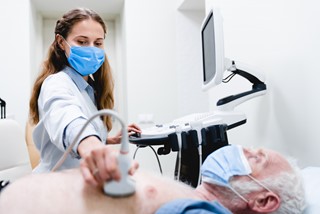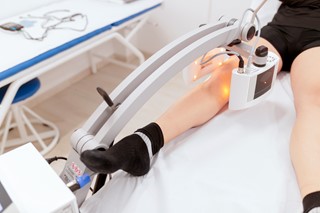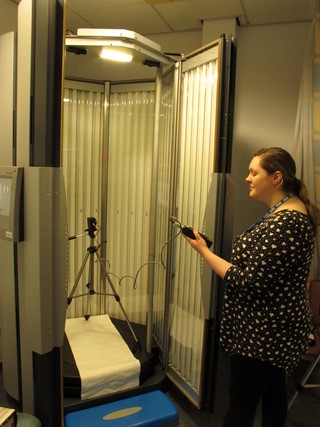Ultrasound and Non-ionising Radiation

What is Non-ionising radiation?
Non-ionising radiation (NIR) is a term used to encompass all electromagnetic radiation where individual photons do not have enough energy to ionise atoms. Medical Ultrasound, the use of high frequency sound waves, is also non-ionising and as such is included in the remit of the non-ionising special interest group (UNIRSIG). Magnetic resonance, while non-ionising, is a huge area of scientific and medical specialism and so has its own special interest group (MR SIG).
What forms of NIR are used in medicine?
- Ultraviolet Radiation
Ultraviolet radiation is invisible electromagnetic radiation lying in the portion of the electromagnetic spectrum between x-rays and visible light. It can be further divided into 3 sections commonly described as UVC from 100nm to 280nm used in many devices designed to decontaminate items of equipment and room surfaces, UVB 280nm to 315nm and UVA 315nm to 400nm – both wavelength bands being used in medical applications.
- Visible light and Infrared sources including Lasers.
Visible radiation or light covers the range from 400nm to 700nm. Infrared (IR) covers the spectrum from 700nm to 1mm wavelengths. As with ultraviolet both these bands are used in medicine. Lasers are also available in all these bands, but their outputs are in the form of coherent radiation; radiation where the phase difference between the electromagnetic waves remain constant. Such a broad spectrum enables their use in many medical situations.
- Microwaves, Radio Waves and Static Magnetic Fields
The longer wavelength portion of the electromagnetic spectrum plays an increasing role in the medical field. For Magnetic Resonance Imaging view here.
There are other sources however within the medical sector that use longer wavelength electromagnetic radiation for both diagnostic and therapeutic purposes.
- Ultrasound
Ultrasound is the use of high frequency sound waves to produce images of many tissues and organs within the human body – for example unborn babies, the heart, kidneys etc. It is widely and increasingly used as a point of care tool. It is also used therapeutically to treat patients.
What medical fields use NIR?
Non-ionising radiation is used in a wide range of modalities throughout the medical sector. Electro-magnetic radiations such as visible light, infrared (heat), radio waves, and near ultra-violet, are used to both treat and image patients.

Ultraviolet light for instance can be used to treat many dermatological conditions such as psoriasis and eczema and is increasingly being used in decontamination due to the ability of shorter wavelength (UVC) radiation to kill bacteria and viruses. Ultraviolet lasers are used to reshape the cornea in corrective eye surgery.
Visible light has many applications, not only the obvious (we need visible light to see) but also in therapeutic applications such as blue light phototherapy used to treat neonatal jaundice, Photo Dynamic Therapy (PDT) involves a light source to activate a light sensitive chemical (photosensitiser) applied to the area to be treated or taken systemically to destroy abnormal cells. PDT is used to treat a wide range of dermatological conditions including some skin cancers, and additionally to treat other conditions such macular degeneration, Barrett's oesophagus and other cancers such as oesophageal cancer, mouth cancer and lung cancer.
Light can also be used to image inside the body. For example, stroke victims and premature babies can be scanned using light-based techniques including diffuse optical tomography that can monitor blood volume, oxygen content and flow. Another technique based on light, Optical Coherence Tomography, is used to diagnose retinal disease. IR can be used to relieve pain and improve circulation for physiotherapy patients.
Therapeutic uses of longer wavelength radiation include electrosurgery which uses high frequency electromagnetic currents to cut and coagulate tissue enabling surgical procedures to be undertaken with minimal blood loss. Microwave and radiofrequency radiation is used in tumour ablation via thin probes to cause heating and so tumour necrosis. Physiotherapy uses these wavelengths to warm selective areas of the body, for example for pain relief.
Laser radiation has unique properties; a narrow wavelength spectrum allowing it to target certain light absorbing molecular structures within the body, alongside the ability to focus high power output down to a small spot. Lasers are used widely across many medical specialisms, including Ophthalmology, Dermatology, Surgery, Cardiology and Urology. Laser ablation is used to treat a wide variety of carcinomas keeping normal tissue damage as low as possible and be minimally invasive. Lasers treat conditions as diverse as retinal detachment and destruction of abnormal retinal vessels, fragmentation of kidney stones through to aiding the removal of faulty pacemaker leads. They are also used widely in the diagnosis of medical conditions such as optical coherence tomography used to obtain detailed images of the structure of the retina. New therapeutic and diagnostic applications are being investigated in this widely diverse field.

How do these techniques work?
Ultraviolet Phototherapy is a method of treating a wide variety of skin disorders such as eczema, psoriasis and vitiligo. In a medical environment the radiation generally originates from fluorescent tubes metal halide lamps and increasing now light emitting diodes. It is delivered to the patient in safe and calibrated doses via whole body cabinets for treating the whole body, or smaller units used to treat only certain parts of the body such as the hands or feet. Therapy works by impact on the body’s inflammatory and auto immune responses.
Shorter wavelengths of visible light can induce chemical changes in certain molecular structures within the body. This effect is used in the treatment of neonatal jaundice changing trans-bilirubin into the water-soluble cis-bilirubin isomer making it easier for the baby’s liver to remove the bilirubin from the baby’s blood. In PDT, light wavelengths are selected to induce chemical changes in the photosensitiser which in turn leads to the production of singlet oxygen free radicals and leads to cell death, thereby treating the medical condition.
The wavelength of a laser is selected so that the energy from the laser will be selectively absorbed by certain chemical structures within the body, enabling that specific structure to absorb energy resulting in effects from protein denaturation to photo-carbonisation.
In an ultrasound scan, a handheld probe that produces ultrasound waves is moved over the skin above the part of the body that needs to be looked at. The ultrasound waves that are bounced back by the different vessels and organs within the body that they hit are detected by the sensor and turned into an image by computer. Therapeutically, physiotherapists use ultrasound to warm tissue and improve blood flow by a streaming effect.
Optical Coherence Tomography (OCT) is the optical equivalent of ultrasound and uses a beam of infrared radiation from a laser instead of sound waves. In diffuse optical tomography, boundaries between different internal structures including cell membranes reflect and scatter the infrared light of different wavelengths that is shone at them. Different amounts of oxygen in tissues absorb specific wavelengths of light, so the reflected light is processed by computer to produce a 3D image that reveals areas starved of oxygen - for example during a stroke - and with too much oxygen - as with a growing cancerous tumour.
Source safety
All these techniques have the advantage that their energy levels are not sufficiently high to cause ionisation of atoms within tissues. However, the principle of reducing any exposure to as low as reasonably achievable is just as applicable as it is in ionising radiation.
One of the important activities of the UNIRSIG is to maintain the safe uses of all sources of non-ionising radiation within the medical sector both for staff and patients. This includes compliance to the Control of Artificial Optical Radiation Regulations (2010) and the Control of Electromagnetic Fields at Work Regulations (2016) and advice from relevant bodies such as ICNIRP[SC(NCT1]. In ultrasound safety advice is issued by BMUS. The UNIRSIG works to address issues surrounding the safe and effective use of such sources and provides advice and disseminates information as appropriate.
Future developments
Non ionising radiation is a rapidly developing field. Technology and research are helping introduce exciting new treatments. For example, UVC light is being increasingly used in ward decontamination, it does however have some significant safety concerns which need addressing.
Lasers and optical radiation are being used in new areas all the time, an example of which includes the use of 1320nm Nd:YAG lasers in cardiothoracic surgery, for example targeting parenchymal tissues where its high absorption has considerable advantages over a 1064nm Nd:YAG laser.
High intensity focused ultrasound (HIFU) is being developed for use in the treatment of cancer and is currently undergoing clinical trials in the UK. In the future, it may be used to kill cancer cells in single tumours or parts of larger tumours in prostrate, kidney, liver, and bladder cancer. There are also prototype optical mammography systems undergoing testing, and another light-based technique known as photoacoustic imaging - which can reveal signs of disease via unusual patterns in blood oxygen content and flow - is in the early stages of clinical trials. OCT may become routinely used in many areas of medicine within the next few years and has been proven to detect the difference between cancerous and normal tissue in the gut and skin.
Highly portable handheld diagnostic ultrasound devices connected to tablets are entering clinical use, which are extremely useful in responding to the challenge of Covid 19. Situations like pandemics are drivers for the UNIRSIG and the NIR community to develop the field. For example, near UVC 220nm emitters for sterilisation.
With such a wide variety of rapidly developing medical fields, non ionising radiation and ultrasound have an exciting and interesting future; extremely rewarding those that devote their time to the field.
Careers in Ultrasound and Non Ionising Radiation
Meet Ariona and Ryan, Clinical Scientists in MRI and Ultrasound Physics and explore more about their roles.